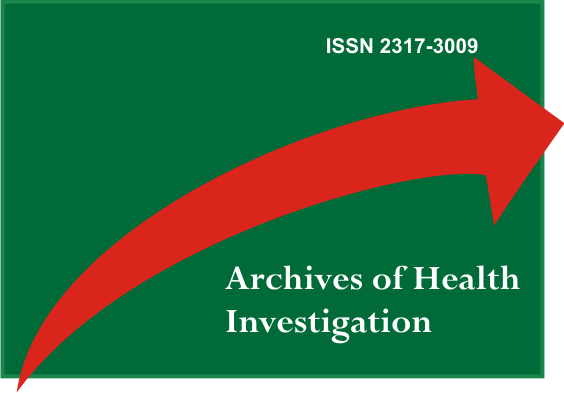Reação do tecido conjuntivo subcutâneo de ratos ao implante de Hipoglós®
DOI:
https://doi.org/10.21270/archi.v6i1.1786Resumo
Introdução: a mucosa bucal é susceptível a lesões de origem externa ou interna, causados por diferentes agentes físicos, químicos e biológicos. Vários são os medicamentos testados para o tratamento das lesões da mucosa bucal. Objetivo: o propósito deste trabalho foi avaliar, microscopicamente em ratos, a reação do tecido conjuntivo subcutâneo ao implante de Hipoglós®. Material e Método: foram realizadas, no dorso de 15 animais incisões medindo 1 cm cada, com distância entre elas de 3 cm. A partir daí, dois grupos experimentais foram constituídos: Grupo I – Controle (tubo de polietileno vazio); Grupo II - Hipoglós® (tubo de polietileno contendo Hipoglós®), considerando os períodos de 7, 15 e 21 dias, com cinco animais em cada um. Resultados: na análise histológica, o Grupo II (Hipoglós®) mostrou ainda células inflamatórias aos 21 dias, apesar de estatisticamente esse grupo ter apresentado melhores resultados quando comparado ao grupo I (Controle). Conclusão: em razão dos seus componentes e da semelhança de resposta inflamatória com o grupo controle, a pomada Hipoglós® mostrou-se biocompatível em tecido conjuntivo subcutâneo de ratos e abre a perspectiva para a realização de outras pesquisas.Descritores: Vitamina A; Vitamina D; Óxido de Zinco; Tecido Conjuntivo.
Downloads
Referências
Al Maweri SA, Al Jamei AA, Al Sufvani GA, Tarakji B, Shugaa-Addim B. Oral mucosal lesions in elderly dental patients in Sanaá, Yemen. J Int Soc Prev Community Dent. 2015; 5(Suppl 1):S12-9.
Altenburg A, El-Haj N, Zoubolis CC. The treatment of chonic reccurent oral aphthous ulcers. Dtsch Arztbel Int. 2014; 111(40):665-73
Lima AS, Grégio AMT, Tanaka O, Machado MAN, França BHS. Tratamento das ulcerações traumáticas bucais causadas por aparelhos ortodônticos. R Dental Press Ortodon Ortop Facial. 2005; 10(5):30-6.
El Beitune P, Duarte G, Morais EN, Quintana SM, Vannucchi H. Vitamin A deficiency and clinical associations: A review. Arch Latinoam Nutr. 2003; 53(4): 355-63.
Pedros MAC, Castro ML. Papel da vitamina D na função neuro-muscular. Arq Bras Endocrinol Metab. 2005; 49(4): 495-502.
Lansdown AB, Mirastschijski U, Stubbs N, Scanlon E, Agre MS. Zinc in wound healing: theorical, experimental and clinical aspects. Wound Repair Regen. 2007; 15(1):2-16
Molloy D, Goldman M, White RR, Kahani S. Comparative tissue tolerance of a new endodontic sealer. Oral Surgery Oral Medicine Oral Pathology. 1992; 73(4):490-3.
Zmener O, Guglielmotti MB, Cabrini RL. Tissue response to na experimental calcium hydroxide-based endodontic sealer: a quantitative study in the subcutaneous connective tissue of the rat. Endod Dental Traumatol. 1990; 6(2): 66-72.
Costa CA, Teixeira HM, do Nascimento AB, Hebling J. Biocompatibility of two current adhesive resins. J Endod. 2000; 26(9):512-6.
Torneck CD. Reaction of rat connective tissue to polyethylene tube implants. I. Oral Surg Oral Med Oral Pathol. 1966; 21(3):379-87.
Ozbas H, Yaltirik M, Bilgic B, Issever H. Reactions of connective tissue to compomers, composite and amalgam root-end filling materials. Int Endod J. 2003; 36(4):281-7.
Sumer M, Muglali M, Bodrumlu E, Guvenc T. Reactions of connective tissue to amalgam, intermediate restorative material, mineral trioxide aggregate, and mineral trioxide aggregate mixed with chlorhexidine. J Endod. 2006; 32(11):1094-6.
Gomes-Filho JE, de Faria MD, Bernabé PFE, Nery MJ, Otoboni-Filho JA, Dezan-Júnior E, et al. Mineral Trioxide Aggregate but not Light-cure Mineral Trioxide Aggregate Stimulated Mineralization. J Endod.. 2008; 34(1):62-5.
Lansdown AB, Mirastschijski U, Stubbs N, Scanlon E, Agren MS. Zinc in wound heling: theoretical, experimental, and clinical aspects. Wound Repair Regen. 2007; 15 (1):2-16.
Davies MW, Dore AJ, Perissinotto KL. Topical vitamin A, or its derivatives, for treating and preventing napkin dermatitis in infants. Cochrane Database Syst Rev. 2005; 19(4):CD004300.
Vaz FAC, Celidônio AL, Nunes J, Martins EL, Martins JEC. Clinical trail with two formulations in the treatment of ammoniacal dermatitis of newborns and infants. An Bras Dermatol. 1993; 68(5):301-2.
Agren MS. Zinc oxide increases degradation of collagen in necrotic wound tissue. Br J Dermatol. 1993 Aug;129(2):221.
Agren MS, Ostenfeld U, Kallehave F, Gong Y, Raffn K, Crawford ME, et al. A randomized, double-blind, placebo-controlled multicenter trial evaluating topical zinc oxide for acute open wounds following pilonidal disease excision. Wound Repair Regen. 2006; 14 (5):526-35.
Reichrath J, Lehmann B, Carlberg C, Varani J, Zouboulis CC. Vitamins as homones. Horm Metab Res. 2007; 39 (2):71-84.
Savafi K. Serum vitamin A levels in psoriasis: Results from the first national health and nutrition examination survey. Arch Dermatol. 1992; 128(8):1130-1.
Orfanos CE, Zouboulis CC, Almond-Roesler B, Geilen CC. Current use and future potential role of retinoids in dermatology. Drugs. 1997; 53(3):358-88.
Lehmann B, Querings K, Reichrath J. Vitamin D and skin: new aspects for dermatology. Exp Dermatol 2004; 13(Suppl 4):11-5.
De Haes P, Garmyn M, Verstuyf A, De Clercq P, Vandewalle M, Degreef H, et al. 1,25-Dihydroxyvitamin D3 and analogues protect primary human keratinocytes against UVB-induced DNA damage. J Photochem Photobiol B. 2005; 78(2):141-8.
Gombard HF, Borregaard N, Koeffler HP. Human cathekicidin antimicrobial peptide (CAMP) gene is a direct target of the vitamin D receptor and is strongly up-regulated in myeloid cells by 1,25-dihydroxyvitamin D3. FASEB J. 2005; 19(9):1067-77.
Diker-Cohen T, Koren R, Liberman UA, Ravid A. Vitamin D protects keratinocytes from apoptosis induced by osmotic shock, oxidative stress, and tumor necrosis factor. Ann N Y Acad Sci. 2003; 1010:350-3.


